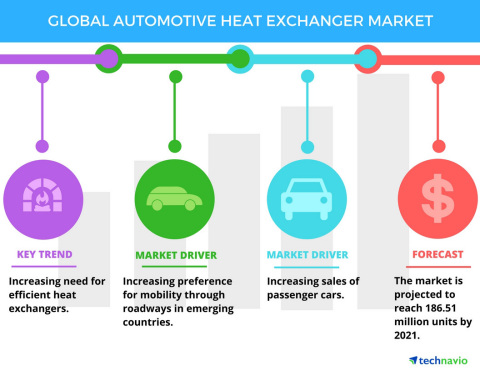LONDON--(BUSINESS WIRE)--Technavio market research analysts forecast the global automotive heat exchanger market to grow at a CAGR of close to 5% during the forecast period, according to their latest report.
The market study covers the present scenario and growth prospects of the global automotive heat exchanger market for 2017-2021. The report also lists passenger cars, LCVs, and M&HCVs as the three major application segments, of which the passenger cars segment accounted for close to 88% of the market share in 2016.
According to Praveen Kumar, a lead analyst at Technavio for automotive components research, “The increased demand for HVAC systems has resulted in the growth of the demand for heat exchangers as each HVAC system requires a heat exchanger to cool down and dissipate the excess heat to maintain the optimum performance of the engine.”
This report is available at a USD 1,000 discount for a limited time only: View market snapshot before purchasing
Buy 1 Technavio report and get the second for 50% off. Buy 2 Technavio reports and get the third for free.
Technavio analysts highlight the following three market drivers that are contributing to the growth of the global automotive heat exchanger market:
- Heavy dependence on IC engines for mobility in emerging countries
- Increasing sales of passenger cars
- Stringent fuel economy norms leading to the production of advanced thermal management systems
Heavy dependence on IC engines for mobility in emerging countries
Emerging countries like India and China are witnessing an increase in the preference for mobility through roadways. In 2016, IC engines held a market share of more than 95% of the total vehicles sold globally. In the commercial vehicle segment, there is hardly any vehicle that runs on battery or alternate fuels. Hence, there is a high reliance on IC engines for transportation.
One of the main reasons why road transport is opted for mobility and the transportation of cargo is the limited rail services available. The lack of sufficient rail services for logistics is forcing the freight companies to choose roadways as a reliable mode of transportation. Thus, IC engines play a key role in providing easy mobility and transporting cargo, which will drive the demand for automotive heat exchangers.
Increasing sales of passenger cars
The sales of passenger cars are correlated with the market growth of automotive heat exchangers as all passenger cars are equipped with a heat exchanger. The passenger car segment contributed to 88% of the global automotive heat exchanger market in 2016. The global car sales increased by around 3% in 2015 with SUVs and crossovers accounting for most of the sales in the Chinese and European passenger car markets. The SUV segment in Europe recorded an increase in its market share by 27% in 2015.
“Thus, the increase in the sales of passenger cars will drive the demand for heat exchangers as most of the cars are equipped with more than one heat exchanger,” says Praveen.
Stringent fuel economy norms leading to the production of advanced thermal management systems
All the global economies are focusing on restricting carbon emission. In Europe, 25% of the carbon dioxide is emitted by vehicles. As a result, European nations are trying to restrict the carbon emission by implementing stringent carbon emission rules. In 2014, Europe introduced the Euro VI norms, which aimed mainly at reducing the emission of nitrogen and particulate matters and improving the fuel economy.
The thermal management of the vehicle is an important area where OEMs are focusing on to improve the fuel efficiency of their vehicles. The improved thermal management can improve the fuel economy of the vehicle by 2%-5%. Thus, stringent emission norms are leading OEMs to enhance their thermal management systems, which will eventually drive the global automotive heat exchanger market.
Browse Related Reports:
- Global Automotive Seats Market 2017-2021
- Global Two-wheeler Upside-down Forks Market 2017-2021
- Global Commercial Vehicle Poly-V Belt Market 2017-2021
Become a Technavio Insights member and access all three of these reports for a fraction of their original cost. As a Technavio Insights member, you will have immediate access to new reports as they’re published in addition to all 6,000+ existing reports covering segments like powertrain, wheels and tires, and automotive electronics. This subscription nets you thousands in savings, while staying connected to Technavio’s constant transforming research library, helping you make informed business decisions more efficiently.
About Technavio
Technavio is a leading global technology research and advisory company. The company develops over 2000 pieces of research every year, covering more than 500 technologies across 80 countries. Technavio has about 300 analysts globally who specialize in customized consulting and business research assignments across the latest leading edge technologies.
Technavio analysts employ primary as well as secondary research techniques to ascertain the size and vendor landscape in a range of markets. Analysts obtain information using a combination of bottom-up and top-down approaches, besides using in-house market modeling tools and proprietary databases. They corroborate this data with the data obtained from various market participants and stakeholders across the value chain, including vendors, service providers, distributors, re-sellers, and end-users.
If you are interested in more information, please contact our media team at media@technavio.com.




